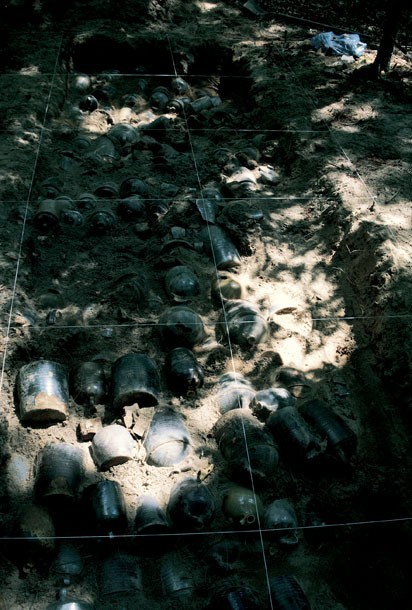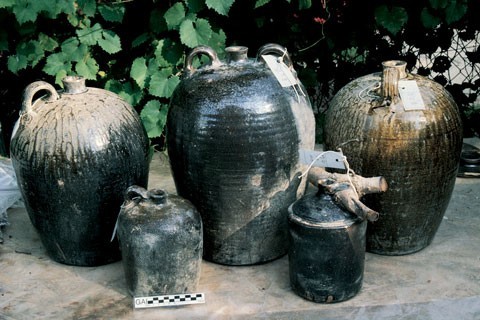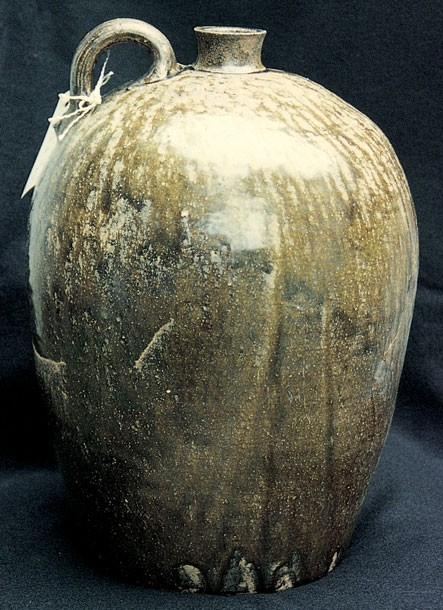
Seven-meter trench opened up over seventeen-meter feature showing grid installation. (Courtesy, Georgia Archaeological Institute.)

Detail of a single grid unit showing partially excavated vessels.

A sample of recovered vessels. Back row: (Left) Three-gallon ovoid jug. H. 15 1/5". Stoneware with alkaline ash run glaze. (Center) Five-gallon two-handled ovoid jug. H. 17". Stoneware with alkaline glaze. (Right) Three-gallon ovoid jug. H. 15 1/5". Stoneware with alkaline glaze. Front Row: (Left) One-quart stacker jug with alkaline glaze. H. 8 1/4". Note the root growing through handle loop. (Right) One-quart stacker jug. H. 8 1/5". Stoneware with Albany slip glaze. This neck style is attributed to Thomas Hahn, son of W. F. Hahn. All vessels circa 1883–1889.

One-quart stacker jug stamped “mark.” Mark Baynham, 1883–1889. H. 8 1/4". Stoneware with alkaline glaze. A cylindrical neck is a diagnostic of this potter.

Three-gallon, single-handled, ovoid jug, ca. 1883-1889. H. 15". Stoneware with alkaline glaze. This neck style is attributed to Thomas Hahn.
In the fall of 1997, the Georgia Archaeological Institute (GAI) in Augusta began the second phase of a program to reevaluate certain nineteenth-century pottery sites within South Carolina’s Old Edgefield District. Pottery production in this area had started at the turn of the nineteenth century.[1] The Edgefield potters characteristically used wood ash to make alkaline glazes that produced spectacular effects and colors on their vessels, many of which were further enhanced with sgraffito and kaolin slip-trailed decorations. The alkaline-glaze tradition died out shortly after the turn of the twentieth century.
One pottery site examined near Trenton, South Carolina, was operated by Joseph Gregory Baynham. Earlier research suggested that Baynham was not part of the Edgefield alkaline-glaze tradition and had arrived in the area in 1900 from Ohio.[2] However, subsequent family[3] and collector interviews[4] and archival research conducted by GAI indicated that Baynham had come to the area in 1865 and was well known for both alkaline glaze and Albany slipwares.
The site was resurveyed by GAI in the summer of 1997 and archaeological testing quickly confirmed that Baynham not only occupied the area in the 1870s but had built his operation on top of an older pottery operated by Lewis Miles and his son John. Prior to the survey, it had been generally accepted that in thirty years of collector interest, all of the known Edgefield pottery sites had been significantly disturbed by amateur researchers and so-called pot hunters. Thus, the discovery of intact vessels on the site was not expected.
One test unit, excavated close to a series of mounds, was thought to represent the remains of a ground-hog kiln. A two-inch layer of humus was removed at the location by archaeologist Nick Nichols. But instead of finding soil, Nichols encountered an intact three-gallon stacker jug. Carefully removing the jug so that testing could continue, Nichols then discovered that more three-gallon stacker jugs lay beneath and on all four sides of the first find.
Work elsewhere on the site was called to a halt as a larger two-meter by seven-meter area was cleared. Eventually more excavation exposed the entire feature, a sixteen-meter-long gully running roughly from north to south that had been filled with intact jugs (fig. 1). Excavation of the feature’s upper section, consisting of five layers of vessels ranging in size from one quart to five gallons, was completed in the winter of 1997; the lower section, during the 1998–1999 season (fig. 2).
Vessel styles included stacker jugs, round-shouldered “beehive” jugs, and transitional, slope-shouldered stacker jugs (fig. 3). In addition, poultry fountains, churns, preserve jars, deep bowls (commonly called cream risers), and spectacular three- and five-gallon ovoid vessels were found. A number of South Carolina glass dispensary bottles and patent medicine bottles were recovered as well.
In all, a total of 674 intact vessels were excavated. An additional 100 vessels were represented as sherds that will eventually be reassembled. GAI, a private research foundation with mostly volunteer staff, continues to catalog and analyze the finds. A final report has been produced, and some preliminary statements can now be made.[5]
Based on the presence of the tightly datable dispensary bottles and other documentary evidence, it appears that the gully was filled with rejected vessels made between 1883 and 1889. Vessel styles have also helped identify four particular potters: Mark Baynham (fig. 4) and Horace Baynham, both sons of the owner, and W. F. Hahn and his son Thomas L. Hahn (fig. 5).
Analysis of the vessels confirmed that ovoid, beehive, and stacker forms were all being made concurrently, contrary to the belief that the ovoid and beehive forms were earlier in tradition than the stacker jugs. Other evidence from the site shows that the use of alkaline glazes extended well into the twentieth century. It was also apparent that there was no clear-cut transition from locally-made alkaline glazes to commercially-made slip glazes. Many vessels demonstrated that both types of glazes were used at the same time.
Most intriguing, preliminary analysis has produced a large number of vessels with identifiable fingerprints in the glaze on bases and handles. Nichols is now collecting data on the fingerprints with the help of a protocol developed by the Savannah Police Department. He hopes to match prints taken from other area sites.
As full statistical analysis nears completion, indications are that it will throw new light on the production of the Joseph Gregory Baynham pottery. Expectations are high that evaluation of the data will also provide a unique glimpse into the day-to-day work of four well-known Edgefield potters.
Mark M. Newell, Ph.D.
Director
Georgia Archaeological Institute
<mmnewell@yahoo.com>
Catherine W. Horne, ed., Crossroads of Clay (Columbia, S.C.: McKissick Museum, University of South Carolina, 1990).
George Castille, Carl Steen, and Cinda Baldwin, An Archaeological Survey of Alkaline Glazed Stoneware Production Sites in the Old Edgefield District (Columbia, S.C.: McKissick Museum, University of South Carolina, 1988); and Carl Steen, An Archaeological Survey of Pottery Production Sites in the Old Edgefield District of South Carolina (Columbia, S.C.: Diachronic Research Foundation, 1994).
Nancy Baynham, Baynham, A South Carolina Family (Augusta, Ga.: Hamburg Press, 2000).
Mark Newell and Nick Nichols, The Riverfront Potters of North Augusta (Augusta, Ga.: Georgia Archaeological Institute, 1998).
Mark Newell, Joseph G. Baynham: A Re-Evaluation of 38ed221 (Augusta, Ga.: Georgia Archaeological Institute, 2000).
